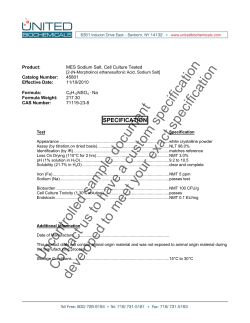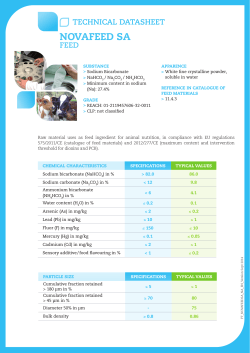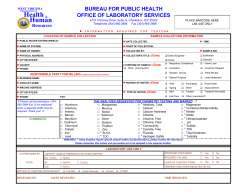
A double replacement reaction happens when ionic s
Ellie Puttman Lab Partner: Matt Parker Double Replacement Reactions Abstract: A double replacement reaction happens when ionic solutions mix together to form precipitates. The purpose of this experiment was to determine which combination of ionic solutions form precipitates because double replacement reactions occurred. This was achieved by mixing different ionic solutions together and observing the results. The purpose was accomplished as all of the precipitates were identified correctly and only a few errors could have occurred. Introduction: A double replacement reaction is when atoms from two different compounds replace each other. These reactions happen every day and the most common reaction is between two ionic compounds that are dissolved in water. The two cations in the reaction replace each there and the products are a precipitate, gas or water. In this experiment, several pairs of aqueous solutions and ionic compounds will be mixed together. Observations will be made for which combinations produce a precipitate and balanced equations will be written for the equations. Purpose: The purpose of this experiment is to determine which combinations of ionic solutions form precipitates to find when a double replacement reaction has occurred. Procedure: The wells of the well plate were labeled and the well plate was placed on a white piece of paper. A micropipette was used to place five drops of silver nitrate solution into each of the wells: A1 through A4. Five drops of iron (III) nitrate solution were placed into the wells B1 through B4, and five drops of copper (II) nitrate solution were placed into the wells C1 through C4. A different ionic compound was added to each column of wells without contamination. Five drops of sodium phosphate were added to each of the wells A1, B1 and C1. The solutions were observed and it was determined whether or not a precipitate was formed and recorded. Five drops of sodium sulfate solution were added to each other solutions in wells A2, B2 and C2. The solutions were observed and it was determined whether or not a precipitate was formed and recorded. Five drops of sodium hydroxide solution was added to wells A3, B3 and C3. The solutions were observed and it was determined whether or not a precipitate was formed and recorded. Five drops of sodium chloride solution was added to wells A4, B4 and C4. The solutions were observed and it was determined whether or not a precipitate was formed and recorded. A dropper was used to pull up silver solution in row A and deposit to specified container. Results: Observation Table: A Ionic Solutions Ag+NO3- B Fe3+NO3- C Cu2+NO3- 1 Na+PO43Precipitate: Y Color: Darker Yellow Precipitate: Y Color: Cloudier Precipitate: Y Color: Cloudy Blue 2 Na+SO42Precipitate: No 3 Na+OHPrecipitate: Y Color: Brown 4 Na+ClPrecipitate: Y Color: White Precipitate: No Precipitate: Y Color: Dark Orange Precipitate: Y Color: Darker Blue Precipitate: No Precipitate: No Precipitate: No Complete Balanced Equations: o o o o o o o o o o o o A1: 3AgNO3(aq) + Na3PO4(aq) Ag3PO4(s) + 3NaNO3(aq) A2: NO REACTION A3: AgNO3(aq) + NaOH(aq) AgOH(s) + NaNO3(aq) A4: AgNO3(aq) + NaCl(aq) AgCl(s) + NaNO3(aq) B1: Fe(NO3)(aq) + Na3PO4(aq) FePO4(s) + 3NaNO3(aq) B2: NO REACTION B3: Fe(NO3)3(aq) + 3NaOH(aq) Fe(OH)3(s) + 3NaNO3(aq) B4: NO REACTION C1: 3Cu(NO3)2(aq) + 2Na3PO4(aq) Cu3(PO4)2(s) + 6NaNO3(aq) C2: NO REACTION C3: Cu(NO3)2(aq) + 2NaOH(aq) CuOH2(s) + 2NaNO3(aq) C4: NO REACTION Conclusion: The purpose of this experiment was to determine which combinations of ionic solutions form precipitates and to find when a double replacement reaction has occurred when those solutions mix together. This purpose was accomplished as the combinations of solutions with precipitates were correctly identified. In addition, when each of the combinations that formed precipitates, were mixed, a double replacement reaction occurred. For A1 (Silver nitrate mixed with sodium phosphate), A3 (Silver nitrate and sodium hydroxide), A4 (Silver nitrate and sodium chloride), B1 (Iron (III) nitrate and sodium phosphate), B3 (Iron (III) nitrate and sodium hydroxide), C1 (Copper (II) nitrate and sodium phosphate), and C3 (Copper (II) nitrate and sodium hydroxide) precipitates formed and a double replacement reaction occurred. The precipitates that formed in column one of A1, B1 and C1 were silver phosphate, iron (III) phosphate and copper (II) phosphate. The complete balanced equations of column 1 were: A1: 3AgNO3(aq) + Na3PO4(aq) Ag3PO4(s) + 3NaNO3(aq) B1: Fe(NO3)(aq) + Na3PO4(aq) FePO4(s) + 3NaNO3(aq) C1: 3Cu(NO3)2(aq) + 2Na3PO4(aq) Cu3(PO4)2(s) + 6NaNO3(aq) The cation that reacted to form precipitates the most was silver. The positive ion reacted with all but one other solution and that solution of sodium sulfate had the potential to have a slight precipitate. This was most reactive because it had a plus one charge, meaning it only had to get rid of one valence electron. It also had a higher electronegativity. Therefore, with all those characteristics it would be most reactive. For all solutions mixed with sodium sulfate (A2, B2 and C2), B4 (Iron (III) nitrate and sodium chloride), and C4 (Copper (II) nitrate and sodium chloride) no precipitates formed. After observing this, and calculating what would have been the chemical equations for the reactions, it was found that sodium nitrate, silver sulfate, iron (III) sulfate, copper (II) sulfate, iron (III) chloride, and copper (II) chloride all would have been water soluble if a double replacement reaction occurred. Discussion: Even though, the purpose of this experiment to determine which combinations of ionic solutions form precipitates was accomplished, some errors could have occurred. First, contamination of the solutions could have happened, as some of the solution could have dropped into different wells. In addition, the precipitates could have been misidentified, as A2, silver nitrate and sodium sulfate, could have had a light precipitate, and that was not identified, but was accepted. Also, the equipment, such as the pipets and well plates, could have been improperly cleaned, skewing the data. When sodium hydrogen carbonate and sodium chloride are mixed a double replacement reaction would not occur because the cation in both solutions is sodium and the two compounds would not change. In addition, a double replacement reaction usually occurs with two ionic solutions and that reaction forms a precipitate. Being that both solutions are soluble in water, a precipitate would not form. This experiment is revelent to everyday life because double replacement reactions happen throughout the world everyday. They are essential for bodily functions as well as natural functions. In addition, double replacement reactions can help identify unknown solutions and elements that are part of reactions.
© Copyright 2025










